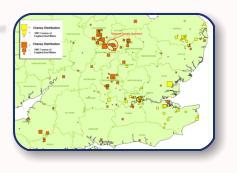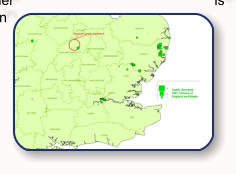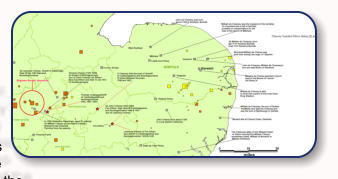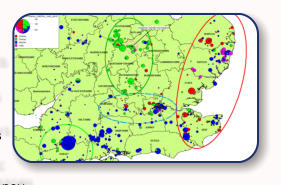
© J.H.Mathieson


An Analysis of the English Origenes Report on the Chaney
Surname
The English Origenes Chaney case study identifies Northamptonshire as the surname's "genetic
homeland". The following is a summary of the evidence Origenes advances in support of the
claim:
•
A table of surname matches at the 37 marker levels including Chaney, Hudson, Hatcher,
and Howard.
•
A table extracted from the 1841 census summarizing by county the distribution of farmers
plus variants and matching surnames.
•
A Google Earth map identifying the location of farmers (Chaney, Hudson, Howard, Hatcher,
and Cady), with a pin representing each farmer or cluster. The place names Middleton
Cheney and Cheyney Farm are also identified. The map includes an orange circle, an area
with a six mile radius, which is identified as the Chaney "genetic homeland". Within the
circle a cluster of "Chaney" farmers is identified. Although the Cady surname does not
appear in the DNA summary table, we are assured that "Mr. Chaney has a close genetic
match to an individual called Cady, which is a rare surname associated with
Northamptonshire".
The Origenes approach focuses on the distribution of farmers and ignores
the surname's broader distribution or its complexities. This is a serious
flaw in its methodology. With the exception of the use of farmer data along
with place name evidence, the approach relies exclusively on its
hypothesis of matching surnames revealed in YDNA tests. It is averse to
using historical sources and approaches developed by surname
researchers.
The question of variant distributions:
In the Chaney case study there was evidently no attempt made
to examine individual surname variants found in the 1841
Census. Rather the Origenes map (Fig 1.) simply plots the
location of "Chaney" farmers to define its "genetic homeland".
Either the author of the case study was unaware of the spatial
differentiation among the Chaney, Cheney, and Cheyney
variants, or simply chose to ignore the issue.
A thorough examination of the variant distributions, along
with a review of relevant historical material, would have
revealed that the Cheney variant is by far the most
common, and that it has a wide distribution covering a
large number of English counties. Historical records point
to Wiltshire, Devonshire, Sussex, Oxfordshire,
Bedfordshire, Hertfordshire, Berkshire, Suffolk, Essex,
Norfolk, Yorkshire, Lincolnshire, and Northamptonshire as
areas of Cheney or Cheyney settlement. These sources
suggest the Cheney spelling variant became standardized during the 17th century. The region
extending from Buckinghamshire, thru Northamptonshire, and into Leicestershire blankets the
"genetic homeland" of the Origenes study (See Fig. 2.). This core area is peppered with
references to place names and buildings attributed to the Cheneys and Cheyneys.
Of particular interest are two references to early Cheneys within or very near to the "Chaney
genetic homeland". In 1399 Katherine Pabenham inherited Engaynes Manor in Pytchley,
Northamptonshire, from her parents. Katherine was married to Sir William Cheyne of Fen Ditton,
Cambridgeshire. In 1436 their son Lawrence Cheyne in turn inherited the manor from his mother.
In 1499 the manor was settled on his son Sir John Cheyne. Previously in 1488 Sir John's son Sir
Thomas Cheney had inherited a second manor in Irthlingborough, Northamptonshire, also by
marriage. On his death in 1514 the manor at Irthlingborough passed to his nine-year-old daughter
Elizabeth who was betrothed to Thomas Vaux, later to become the second Lord Vaux of
Harrowden. These references 1.) point, to the presence of Cheyney/Cheney land owners in the
heart of the area identified as the Chaney "genetic homeland", and 2.) illustrates the role
inheritance can play in breaking the genetic continuity between surnames and the land.
By way of contrast the Chaney surname distribution is localized on the Norfolk/Suffolk border, in
Essex and in Kent. How then is it possible that Northamptonshire could be identified as the
"genetic homeland" of the Chaney surname? The study simply assumed that the farmers in the
"genetic homeland" were Chaney farmers, presumably because of the presence there of Howard,
Hatcher and Cady farmers, the Chaney matching surnames. However on closer examination we
see:
The Distribution of
Howard farmers is
irrelevant. The surname is
ubiquitous in the south of
England and Howard
farmers are found
everywhere.
There is a single Hatcher
farmer in the vicinity of the genetic homeland, however Hatcher
is
a regional occupational surname (gatekeeper), and is found in
a wide swath across the south of England and could hardly
have originated in Northamptonshire.
The study assures us that Cady is a "rare surname
associated with Northamptonshire". It certainly is rare, but
hardly associated with Northamptonshire where we find a
solitary family. We have to look to Suffolk for the likely
homeland of the Cady surname.
What then of the Chaney farmers? Had the indexes or the actual census images from the
enumerator book been examined, it would have been revealed that the "Chaney" farmers within
the "genetic homeland" were in fact Cheneys. Given that the presence of Chaney farmers within
the "genetic homeland" is key to the case study conclusion, the Northamptonshire hypothesis is
clearly incorrect. It is also evident that the Origenes place name evidence of Cheyney Farm and
Middleton Cheney (which are described on the Origenes map as "Chaney Placenames") support
the observation that the region is one that had been historically inhabited by Cheyneys and
Cheneys, but not by Chaneys. This observation is further supported by a large body of additional
Cheney, Cheyney place name references in the vicinity of the suspected homeland.
The Norman connection:
A second major defect in the Chaney analysis which has led to the misidentification of the
homeland as Northamptonshire is the belief expressed in the study that the Chaney surname is
not Norman in origin, but rather that the Chaney ancestors were Britons. The study states:
Although the Chaney surname is reportedly of Norman origin, Mr Chaney’s R-M269 haplogroup
and the predominance of English and neighbouring-Welsh surnames throughout his Y-DNA
results would indicate that his ancestors were Ancient Britons rather than more recently arrived
Romans, Vikings, Anglo-Saxons or Normans.
To my knowledge there is no proto typical Norman haplogroup, and among the surnames listed at
the 25 marker level we find Norman names, occupational names, topographical names and
surnames based on place names, none of which could in and of themselves be used to identify
the bearer as "Ancient Britons". The failure to consider that the surname might have Norman
origins has seriously compromised any attempt to correctly identify the surname's genetic or
historic origins.
Reaney and other medieval scholars strongly suspected the antecedents of the Cheneys were
Norman. The early Cheneys were truly a dynastic family with strong connection to the seat of
power. This is reflected in the wide distribution of the Cheney and Cheyney surname throughout
the south of England. In 1143 William de Chesney, (also known as William of Norwich or William
fitzRobert) a powerful magnet and supporter of King Stephen, was given control of the town of
Oxford and Oxford Castle. Oxford castle had at one time been in the possession of Odo, Bishop
of Bayeux and half brother of William the Conqueror. Deddington Castle became the center of
William de Chesney's power and influence. Deddington is located just three miles from Middleton
Cheyney in Northamptonshire. Settlements and manors in the region may be responsible for "by
names" which eventually became hereditary in the form of Cheyney and Cheney.
By contrast there is virtually no place name evidence associated with the Chaney surname.
However, the variant is localized in Norfolk, Essex, and Kent, a distribution that would be entirely
consistent with early Norman settlement. A William de Chesney also had power and influence in
much of Norfolk and Suffolk where at various times he was high Sherriff of both shires.
Additionally historical records indicate that in the twelfth and thirteenth centuries the de Chesneys
had extensive ecclesiastical and manorial interests throughout Norfolk . The family appears to
have been centered in Blythsburgh, with links to West Rudham, Wroxham, Hingham and
Norwich. William de Chesney founded Sibton Abby and was a benefactor to Stoke by Clare,
Colne, Castle Acre, Thetford and Blythburgh Priories.
If we identify places linked with William de
Chesney, or members of his family, an
association between the Chaney surname
distribution and these early de Chesney and
Cheney references emerges. This strongly
suggests that the Chaney spelling has Norman
roots in Norfolk. References to the de Chesney
and Cheney surname in subsequent centuries
are absent in Norfolk. However such references
to the west in Cambridgeshire, Huntingdonshire
and Leicestershire intensify. Did the interests of the
Cheney family shift over time? Did individuals bearing the surname move west? Did the Chaney
variant emerge in isolation in Norfolk? These are unanswered questions, but it appears clear that
the Chaney spelling variant had its roots in Norfolk, not Northamptonshire.
What do the DNA surname matches show?
Finally what are we to make of the YDNA association
of Chaney with the matching surnames? Because of
the narrow scope of the Origenes methodology and its
inability to map surname distributions, Origenes was
unable to identify the Norfolk/Suffolk border region as
an area where the surnames Hudson, Howard,
Hatcher Cady, and Chaney are found in large numbers
and in close proximity to one another. However this
observation does not validate the area as the "genetic
homeland" of the Chaneys. The matches between Chaney,
Hudson, and Hatcher which occur at 37/37, might just as easily be the result of non paternity
events which took place in Norfolk within a post surname historical time frame.
An alternative explanation is also possible. The
1790 US census reveals Chaney, Hatcher, and
Howard families in the Chesapeake Bay area.
Given the extreme rarity of Chaney and Hatcher
surnames in this area, and considering the strong
bias toward American test takers in the Family
Tree YDNA database, this possibility also merits
serious consideration through the possible
existence of a non paternity event. Available
documentary research concerning the Chaney customer's genealogical past was omitted from
the case study. Any such research could be pertinent to the interpretation of the DNA matches.
Conclusion
The Origenes hypothesis that the Chaney "genetic homeland" is in Northamptonshire is based on
a complete miss-reading of the census data. Care was not taken to distinguish between the
Cheney and Chaney variants. The "genetic homeland" was a Cheney enclave. There were no
"Chaney" farmers in the Origenes "genetic homeland". While Origenes has often defended its
conclusions by stating that DNA doesn't lie, its Chaney case study illustrates that in the absence
thorough research and in-depth, reliable documentary and spatial evidence, DNA is not capable
of revealing the truth.
The case study was doomed from the start by a failure to understand that variants are often
regional in nature and not simply random events within a broader surname distribution. Variants
develop locally, reflecting migration, and spelling norms. Further, as explained in the article "Can
the Distribution of 19th Century Farmers Be Used To Identify a Surname's Genetic Homeland?",
reliance on the recent distribution of farmers as a marker for an English surname's genetic or
historic origins is a fundamentally flawed approach. The failure to consult available primary
source material only compounded these methodological problems. Had this been done the
Northamptonshire hypothesis would have been rejected immediately.






















